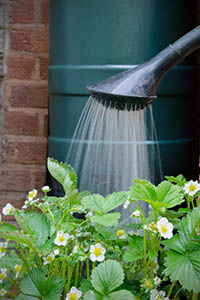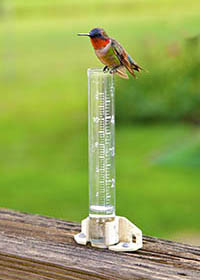This time of year, we’re frequently asked about how and when to water, so we thought a blog post might be helpful!
 The length of time for watering depends on many things, including water pressure, the type of hose used, and the condition of the soil. However, proper watering is one of the most important things you can do to help your new plantings get established (1st year in the ground for most perennials and shrubs, up to 5 years for trees). Here are my tips!
The length of time for watering depends on many things, including water pressure, the type of hose used, and the condition of the soil. However, proper watering is one of the most important things you can do to help your new plantings get established (1st year in the ground for most perennials and shrubs, up to 5 years for trees). Here are my tips!
WATERING GOAL:
Water long and slow enough so the water soaks down to the depth of the roots. Too short a watering time, the roots and surrounding soil may not get water and the root system won’t be able to develop as well. Watering too fast, on the other hand, may result in water rushing off into other parts of the landscape/yard, leaving the plant with just surface water.
BEST METHOD:
The use of a soaker hose or drip irrigation to water plants is best. These water at the ground level, leaving the leaves and flowers free from water droplets that can cause disease. It’s also most efficient, as all the water gets to the soil, where it is needed. If that’s not practical, then using a hose at a very slow pressure to build up a nice pool of water at the base of a plant is good. You can also use Tree Gators or 5 gallon buckets with small holes at the base to give larger trees and shrubs a slow trickle of water. If you use a bucket or drip irrigation, make sure multiple locations around the base of the plant get watered so the whole perimeter gets a deep soaking!
TEST:
There are a variety of ways to see if your watering schedule is correct. Set up your system for whatever you think is appropriate. For new plantings, this may be 1 time per week for 1/2 hour in the spring and every 3-4 days in the heat of summer. After you have watered, stick a metal rod or something similar into the ground. If it’s hard to get it into the soil more than a couple of inches, you need to increase the length of your watering time. When your cycle is almost done and it is time to water again, do this test again. Most plants like the soil to dry out a bit before getting more water, so ideally would be you can get the rod into the ground, but it comes out dry. If it slips in very easily and comes out muddy, then the plants may be getting too much water and you can reduce it.
 That test is the best way to determine if you’re watering the appropriate amount. If you water via spray irrigation, you can set out a plastic container and see if you are getting 1″ of water in the area. Although this isn’t as ideal, it is an easy way to see what’s going on.
That test is the best way to determine if you’re watering the appropriate amount. If you water via spray irrigation, you can set out a plastic container and see if you are getting 1″ of water in the area. Although this isn’t as ideal, it is an easy way to see what’s going on.
THINGS TO CONSIDER:
Certain plants need more water than others. Generally, plants that are happy in the shade like a little more water than plants that are happy in the sun. Also, some plants are very good at demonstrating that they are thirsty. Hydrangeas are the best at this, as they often get limp in the evening. However, don’t be fooled! That may not be a sign of thirst, as the heat of the day is just tough on them! If they are limp in the morning, that is a sign your plants need water.
Watering is a bit tough to get down, but once you get a good idea on how your system works (by doing the test above), it should be fairly automatic. You just may need to increase the frequency of the watering schedule in the heat of summer. And it’s also good to check in on the system every once and awhile. Hoses move, emitters get leaks, automatic timer’s batteries die, etc. Checking in to ensure things are working periodically is always a good thing!
If your plants aren’t looking their best, or you just need some help determining the best watering schedule for your gardens, please give us a call. We’d be happy to help!